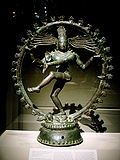
גודל התצוגה המקדימה הזאת: 450 × 600 פיקסלים. רזולוציות אחרות: 180 × 240 פיקסלים | 360 × 480 פיקסלים | 576 × 768 פיקסלים | 768 × 1,024 פיקסלים | 1,704 × 2,272 פיקסלים.
לקובץ המקורי (1,704 × 2,272 פיקסלים, גודל הקובץ: 1.16 מ"ב, סוג MIME: image/jpeg)
היסטוריית הקובץ
ניתן ללחוץ על תאריך/שעה כדי לראות את הקובץ כפי שנראה באותו זמן.
| תאריך/שעה | תמונה ממוזערת | ממדים | משתמש | הערה | |
|---|---|---|---|---|---|
| נוכחית | 15:30, 28 ביוני 2009 |  | 2,272 × 1,704 (1.16 מ"ב) | FlickreviewR | Replacing image by its original image from Flickr |
| 13:06, 10 בפברואר 2009 |  | 1,024 × 768 (405 ק"ב) | Rosemania | {{Information |Description={{en|1=Metropolitan Museum of Art, NYC. Shiva as Lord of Dance (Nataraja), Chola period (880-1279), ca. 11th century Tamil Nadu, India Copper alloy; H. 26 7/8 in. (68.3 cm); Diam. 22 1/4 in. (56.5 cm) Gift of R. H. Ellsworth Lt |
שימוש בקובץ
אין דפים המשתמשים בקובץ זה.
שימוש גלובלי בקובץ
אתרי הוויקי האחרים הבאים משתמשים בקובץ הזה:
- שימוש באתר als.wikipedia.org
- שימוש באתר as.wikipedia.org
- שימוש באתר bg.wikipedia.org
- שימוש באתר bn.wikipedia.org
- שימוש באתר de.wikipedia.org
- שימוש באתר en.wikipedia.org
- Shiva
- Nataraja
- Rudra
- Parvati
- Virabhadra
- Ardhanarishvara
- Ayyappan
- Shaivism
- Pashupati
- Elephanta Caves
- Mount Kailash
- Vibhuti
- Anava
- Banteay Srei
- Phanom Rung Historical Park
- Shaiva Siddhanta
- Kedarnath
- Bhairava
- Siddha
- Trimbakeshwar Shiva Temple
- Bhimashankar Temple
- Somnath temple
- Maha Shivaratri
- Tirumurai
- Om Namah Shivaya
- Shri Rudram
- Kashmir Shaivism
- Rudraksha
- Nayanars
- Nandi (Hinduism)
- Natha Sampradaya
צפייה בשימושים גלובליים נוספים של הקובץ הזה.


 Français
Français Italiano
Italiano


